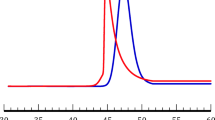Abstract
Chemical reactions between drugs containing reactive amines with hydrolyzable polymers in buffer solutions were investigated. Phenylalkylamines with increasing nucleophilic reactivity were used as model drugs. Solutions of phenylalkylamines were reacted heterogeneously with representative biodegradable polyanhydride and polyester powders in various pH solutions, and the recovery of the amines from the solutions was determined. Poly(sebacic acid), a reactive polyanhydride, reacted by amide formation with the tested amines and their respective HC1 salts when exposed to physiologic pH (pH 7.4). However, at pH 5.0 no interaction occurred. The aromatic polyanhydride, PCPP, and the polyesters based on lactic acid and caprolactone did react with the amine derivatives at pH 7.4, but at a slower rate. The reaction can be avoided with appropriate salt derivatives of the amines.
Similar content being viewed by others
References
R. Langer and M. Chasin (Eds) Polymers as Drug Delivery Systems, Marcel Dekker, New York, NY, 1990.
A. J. Domb, S. Amselem, and M. Maniar, Polyanhydrides: Synthesis and characterization, in Biopolymers, R. Langer and N. Peppas Eds., Springer-Verlag, Heidelberg, VOL. 107:93–141 (1993).
A. Gopferich and R. Langer, Modeling of polymer erosion. Macromolecules, 26:4105–4112 (1993).
K. W. Leong, P. D'Amore, M. Marletta, R. Langer, Biodegradable polyanhydrides as drug-carrier matrices: II. Biocompatibility and chemical reactivity. J. Biomed. Mater. Res., 20:51–64 (1986).
D. H. Lewis, Controlled release of bioactive agents from lactide/glycolide polymers. In: R. Langer and M. Chasin (Eds) Polymers as Drug Delivery Systems, Marcel Dekker, New York, NY, 1990. p. 1–42.
C. G. Pitt and Z. W. Gu, Modification of the rates of chain cleavage of poly(caprolactone) and related polyesters in the solid state. J. Conrol. Rel. 4:283–292 (1987).
A. J. Domb and R. Langer, Polyanhydrides. I. Preparation of high molecular weight polyanhydrides. J. Polm. Sci., Part A, Poylmer Chem. 25:1–14 (1987).
J. C. Liao, C. R. Vogt, Bounded reverse phase ion exchange columns for the liquid chromatographic separations of natural and ionic organic compounds. J. Cromatogr. Sci. 17:237–244 (1979).
C. T. Laurencin, A. J. Domb, C. Morris, and R. Langer, Mechanistic studies of polyanhydride degradation, Proced. Intern. Symp. Control. Rel. Bioact. Mater. 15:248–249 (1988).
A. J. Domb, M. Rock, C. Perkin, B. Proxap, J. G. Villemure, Elimination studies on a radiolabeled biodegradable polymeric implant in the rat brain. Biomaterials, in press.
Author information
Authors and Affiliations
Rights and permissions
About this article
Cite this article
Domb, A.J., Turovsky, L. & Nudelman, R. Chemical Interactions Between Drugs Containing Reactive Amines with Hydrolyzable Insoluble Biopolymers in Aqueous Solutions. Pharm Res 11, 865–868 (1994). https://doi.org/10.1023/A:1018985909777
Issue Date:
DOI: https://doi.org/10.1023/A:1018985909777




